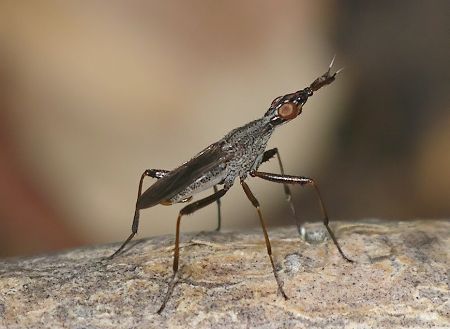by Valerie
December, 2004Cactus Fly If you've never seen an insect like the one pictured above, you are not alone. This strange little creature appeared in our yard only this past summer. I'd never seen anything like it before and it even took awhile to determine that it was indeed in the order Diptera and not Hemiptera or Neuroptera. The clincher was the insects' reaction when I tried to photograph them. Only flies have reflexes so fast that they can evade the flash of a camera and be out of the frame by the time the shutter opens. Once I decided it was a fly, I still had no frame of reference by which to narrow down the identification and so wrote to an eminent Dipterist, Dr. Terry Wheeler, Director of the Lyman Entomological Museum in Canada. He was quick to identify it as a cactus fly (Odontoloxozus longicornis). I had never heard of these, but, armed with the name, I was able to find out more about them. There are only two species of the family Neriidae found in North America, and they are restricted to the southwest. The name comes from the diet of the maggots, which consists of dead or diseased cactus. While cactus flies have been described in association with saguaro cactuses, I found no reference to them on prickly pear (Opuntia sp.), but that is what they prefer in our yard. We do not have the optimum habitat for prickly pear cactus and so our numerous plants are frequently in a state of decay due to lack of sun and crowding by faster growing vegetation. The flies that I observed were very partial to one particular cactus plant that had a dead section. Over a period of several weeks, I watched the fluctuating population of cactus flies on our unfortunate plant. The males are smaller than the females (1/3 inch vs. 1/2 inch in length) and spent more time on the plant, most likely because they had preferred territories. Flies tend to have mating rituals, so when females were present, the flies were very active and both genders were constantly chasing and jumping on each other. It often appeared that the females were very aggressive towards other females and even the males. Because their larvae need a specific type of food, the individual insects must have a vested interest in providing their progeny with the best of the limited resources. The females did not hang around after laying their eggs in the cactus, but there were at least a couple of males that remained for almost two months. Because the cactus plants take several years to slowly succumb to disease or infection, I will not disturb them for at least that long. I'm looking forward to spring when the next generation of cactus flies should emerge and take up residence in our backyard. |